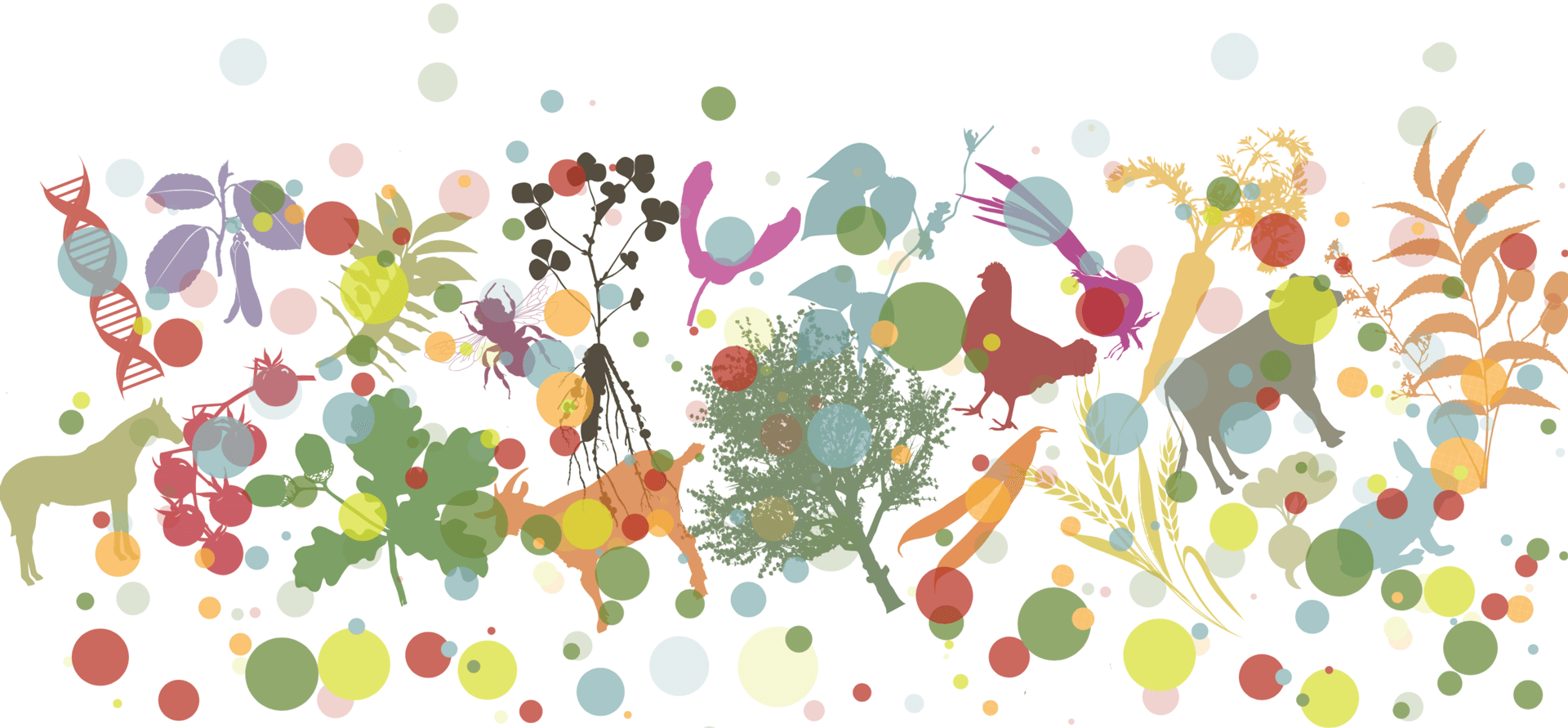Evaluation of red sanders (Pterocarpus santalinus L.f.) germplasm for conservation and breeding
Main Article Content
Abstract
Pterocarpus santalinus L.f., an endangered species endemic to India’s Eastern Ghats, faces threats from illegal trade due to high demand and limited legal supply. Field genebanks are essential for conserving genetic diversity and supporting sustainable use. This study evaluated a 12-year-old P. santalinus germplasm collection of 500 accessions, grown ex situ, for growth and heartwood traits. The survival rate was 80%, with notable variation in tree height (5.5–11.8m), girth at breast height (GBH, 26–78cm), clear bole height (0–6.2m), and heartwood core length (0–6.6cm), indicating substantial genetic diversity. Early heartwood formation (< 12 years) occurred in 18.50% of accessions, earlier than the typical 15 years. Superior accessions included S5R1-19 (6.6cm heartwood) and S7R1-4 (5.5cm), while S1R1-13, S5R4-20, and S1R3-18 exhibited desirable deep red heartwood. Accessions from Petbasheerabad showed high survival and heartwood yield, suggesting their value as elite seed sources. GBH positively correlated with heartwood length (r = 0.443), supporting its use as a selection trait. Principal component analysis and clustering grouped accessions into three clusters: Cluster 1 showed superior timber traits (high clear bole, low percentage of forking), whereas Cluster 3 displayed less desirable traits. These findings aid in identifying elite accessions and developing conservation and breeding strategies. Integration of molecular tools such as genome-wide association studies and transcriptomics is recommended to accelerate genetic improvement.
Article Details

This work is licensed under a Creative Commons Attribution 4.0 International License.
Authors retain copyright of the articles published in Genetic Resources and grant the journal right of first publication with open access. All articles published in Genetic Resource are licensed under Creative Commons Attribution 4.0 International License (CC BY 4.0) that allows others to download, share and adapt the work for commercial and non-commercial purposes as long as proper attribution to the original article is given. Genetic Resources permits and encourages authors to post items submitted to the journal (including the publisher's final layout) on personal websites or institutional repositories after acceptance and/or publication, while providing bibliographic details that credit their publication in Genetic Resources.
Ahmed, M., Nayar, M. (1984). Red sanders tree (Pterocarpus santalinus Linn. F.) on the verge of depletion. Nelumbo 26:142-143. doi: https://doi.org/10.20324/nelumbo/v26/1984/74871 DOI: https://doi.org/10.20324/nelumbo/v26/1984/74871
Ahmedullah, M. (2021). Pterocarpus santalinus. The IUCN Red List of Threatened Species 2021: e.T32104A187622484. doi: https://dx.doi.org/10.2305/IUCN.UK.2021-1.RLTS.T32104A187622484.en DOI: https://doi.org/10.2305/IUCN.UK.2021-1.RLTS.T32104A187622484.en
Ahmedullah, M., Rasingam, L., Swamy, J., Nagaraju, S., Shankara Rao, M. (2019). Non-detriment findings report on the red sanders tree (Pterocarpus santalinus Lf). Botanical Survey of India (Deccan Regional Centre), MoEFCC, Hyderabad.
Arun Kumar, A., Joshi, G., Manikandan, S. (2017). Variability for heartwood content in three commercially important tree species of Peninsular India—Hardwickia binata, Pterocarpus santalinus and Santalum album. In Wood is Good: Current Trends and Future Prospects in Wood Utilization. Springer, pp. 117-126. doi: https://doi.org/10.1007/978-981-10-3115-1_12 DOI: https://doi.org/10.1007/978-981-10-3115-1_12
Arunakumara, K. K. I. U., Walpola, B. C., Subasinghe, S., Yoon, M-H. (2011). Pterocarpus santalinus Linn. f. (Rath handun): a review of its botany, uses, phytochemistry and pharmacology. Journal of the Korean Society for Applied Biological Chemistry 54:495-500. doi: https://doi.org/10.3839/jksabc.2011.076 DOI: https://doi.org/10.3839/jksabc.2011.076
Arunkumar, A. (2011). Variability studies in Pterocarpus santalinus in different aged plantations of Karnataka. My Forest 47:343-353.
Hegde, M. T. (2023). Non-Detriment Findings (NDF) Study For Cultivated Red Sanders (Pterocarpus santalinus L. f.) Trees in Gujarat State. ICFRE - Arid Forest Research Institute (AFRI) Jodhpur, Rajasthan, p. 31.
NBA (2017). Report of the Expert Committee on Red Sanders. A Comprehensive Policy for Conservation, Sustainable use and Fair and Equitable Sharing of Benefits Arising from Utilisation of Red Sanders under the Biological Diversity Act, 2002. National Biodiversity Authority, Chennai.
New, S. (1981). The use of stain by furniture makers 1660—1850. Furniture History 17:51-60.
Pattanaik, S. (2024). Improvement of Redsanders (Pterocarpus santalinus L. f.) through the All India Co-ordinated Research Project (AICRP). Wood is good. IWST, Bengaluru, pp. 151-154.
R Core Team (2018). R: A language and environment for statistical computing. R Foundation for Statistical Computing, Vienna, Austria. https://www.R-project.org/
Schmidlin, L., Poutaraud, A., Claudel, P., Mestre, P., Prado, E., Santos-Rosa, M., Wiedemann-Merdinoglu, S., Karst, F., Merdinoglu, D., Hugueney, P. (2008). A stress-inducible resveratrol O-methyltransferase involved in the biosynthesis of pterostilbene in grapevine. Plant Physiology 148:1630-1639. doi: https://doi.org/10.1104/pp.108.126003 DOI: https://doi.org/10.1104/pp.108.126003
Senthilkumar, N., Mayavel, A., Subramani, S., Balaji, K., Deenathayalan, P. (2015). Red sanders, Pterocarpus santalinus L. in Rajampet forest range, Rajampet forest division, Andhra Pradesh, India. Adv Appl Sci Res 6:130-134.
Seshadri, T. (1972). Polyphenols of Pterocarpus and Dalbergia woods. Phytochemistry 11(3):881–898. doi: https://doi.org/10.1016/S0031-9422(00)88430-7 DOI: https://doi.org/10.1016/S0031-9422(00)88430-7
Suresh, K., Hegde, M., Deenathayalan, P., Karthick Kumar, P., Thangapandi, M., Gurudev Singh, B., Krishnakumar, N. (2017). Variation in heartwood formation and wood density in plantation-grown Red Sanders (Pterocarpus santalinus). In Wood is Good: Current Trends and Future Prospects in Wood Utilization. Springer, pp. 139-151. doi: https://doi.org/10.1007/978-981-10-3115-1_14 DOI: https://doi.org/10.1007/978-981-10-3115-1_14







 This journal has been conceived as part of the
This journal has been conceived as part of the